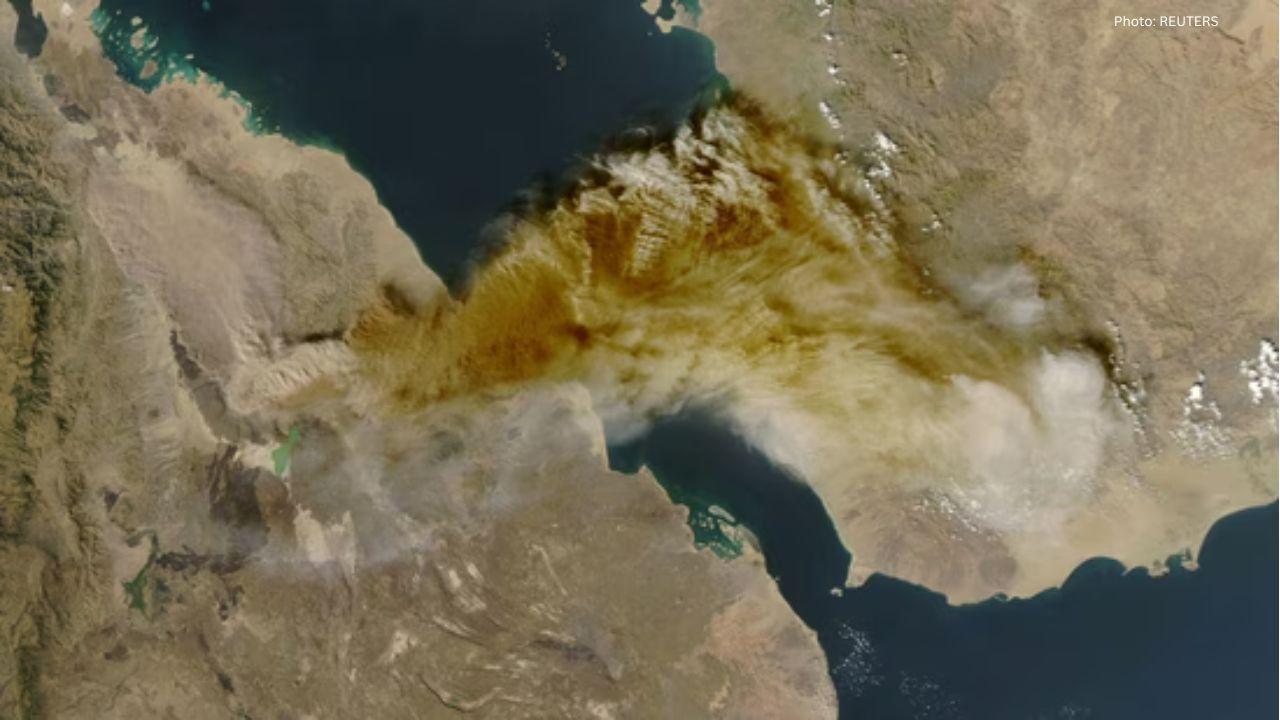
Post by : Saif Al-Najjar
This week, residents of Delhi and parts of northern India witnessed an unusual phenomenon as volcanic ash from the Hayli Gubbi volcano in Ethiopia ascended into their skies. The eruption, which had been dormant for nearly 12,000 years, sent a significant ash plume into the atmosphere on Sunday, carried by powerful winds over vast distances and prompting local meteorological agencies to keep a close watch on its path.
Reports indicate the volcanic plume soared approximately 14 kilometres high, propelled by winds travelling at speeds of 100 to 120 km/h across the Red Sea, Yemen, Oman, over the Arabian Sea, and then onto Gujarat, Rajasthan, Delhi, Haryana, and Punjab. Officials from India clarified that the ash remained in the upper atmosphere, avoiding any mixing with ground-level pollutants.
Experts from the India Meteorological Department (IMD) noted that residents in Delhi may have observed a slightly hazy sky or altered sunlight for several hours. M. Mohapatra, the IMD Director General, reassured that the ash was situated well above the ground level and posed no substantial risk to air quality in the city. By late Monday, much of the ash plume had drifted east towards China and begun to disperse.
Weather monitors verified that only a thin dust layer and minor traces of sulfur dioxide remained at about 40,000 feet high. These residues are expected to dissipate rapidly, presenting little discomfort to those below. While there is no immediate threat for India, experts caution that volcanic ash can present health risks under certain situations.
The International Volcanic Health Hazard Network has noted potential issues such as respiratory difficulties, eye irritation, and skin sensitivity attributed to volcanic ash. The risks may heighten if the ash settles on the ground and becomes airborne again due to movements or winds. Visibility may also decrease, posing hazards for outdoor activities and driving.
In light of such circumstances, specialists recommend straightforward precautions for residents. Staying indoors and avoiding unnecessary travel until the skies are clear is advised. Keeping windows and doors shut may help ensure ash doesn’t enter homes. For individuals needing to venture outside for cleanup duties, using appropriate dust masks is advisable. A clean cloth mask can serve as an alternative if a proper mask isn't available. Those with respiratory issues, like asthma or chronic bronchitis, are urged to limit exposure.
Goggles are recommended to shield eyes from irritation. Generally, drinking water with a light ash exposure is safe after filtering. However, rainwater systems should be covered to avoid contamination, and freshly harvested vegetables should be thoroughly washed before consumption. Children are also encouraged to remain indoors and avoid vigorous physical activities until conditions stabilize.
Despite the rarity and drama of the situation, experts maintain that the overall risk to the population in India is very low. The residents of Delhi and its neighboring areas experienced merely a visual encounter with the cloud rather than any alarming pollution. Nonetheless, basic precautions are advisable until all traces of the high-altitude ash have cleared from the environment.










Gabba Curator Ensures Balanced Conditions for Ashes Test
Gabba's pitch for the second Ashes Test is set to support both batters and bowlers, promising an exc

Hazlewood and Cummins Step Up Training for Ashes Showdown
Josh Hazlewood and Pat Cummins bolster Australia's pace attack as they intensify training ahead of t

Kings Defeat Senators 2-1, Securing Season Sweep
The Kings clinched a 2-1 victory over the Senators, with Clarke scoring the decisive goal as Kuemper

Florida Panthers Triumph Over Nashville Predators with 8-3 Victory
Florida Panthers dominated Nashville Predators with an 8-3 win, highlighted by A.J. Greer's stellar

Kyrgios to Compete in Kooyong Classic Before 2026 Australian Open
Nick Kyrgios is ready to make his comeback at the Kooyong Classic, preparing for the 2026 Australian

South Africa Sets India a 549 Run Chase After Second Innings Declaration
South Africa declared at 269-5, setting India a daunting 549-run target. Tristan Stubbs scored 94 wh